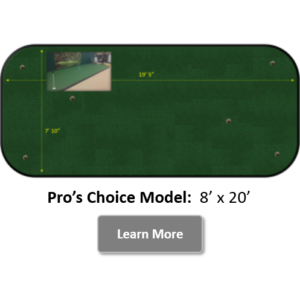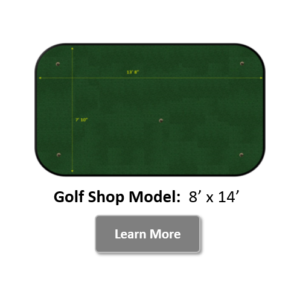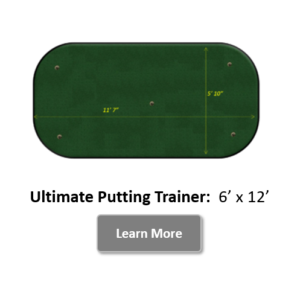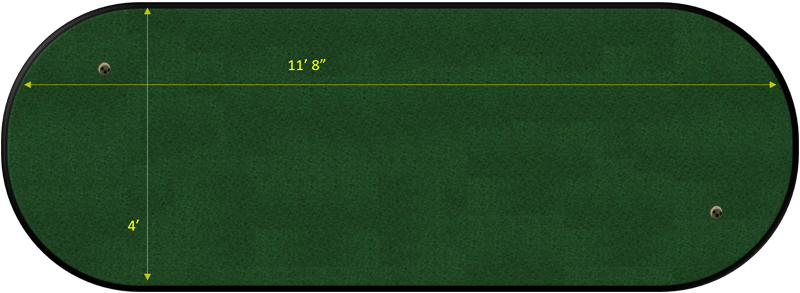Dave Stockton is a legendary putting and short game coach for many of the PGA Tour’s most prominent players. Stockton and his sons Ronnie and Dave Jr. have built a short game consulting empire in recent years.
Watch: Dave Stockton’s Putting Videos
Stockton family clients include Phil Mickelson, Rory Mcllroy, JB Holmes, Anika Sorenstam, Michelle Wie and the list goes on.
What is it that makes Dave Stockton, Ronnie Stockton and Dave Stockton Jr. such influential putting gurus?
The Dave Stockton Secret
Stockton’s secret doesn’t lie in some sort of miracle tip, astonishing breakthrough in technology or amazing new putting grip. Nope, the secret lies in a philosophy, not a technique.
Napoleon Hill wrote in his legendary 1937 classic “Think and Grow Rich” something which holds true even in putting today:
Anything the mind can conceive and believe, the mind can achieve.
Stockton’s Signature Putting Theory
Think about the unconscious act of writing your signature, you can do it over and over again and it will look exactly alike each time you write it. Conversely, sit down and try to think about writing your signature and try to write it very slow thinking about each letter, it won’t look anything like your unconscious signature.
This is because the act of writing your signature is embedded in your sub-conscious mind, when you bring the thought of writing your signature into the forefront of your consciousness, it is no longer unconscious.
The Book – Unconscious Putting: Dave Stockton’s Guide to Unlocking Your Signature Stroke
Once you realize that putting is more effectively done on an unconscious level, you’ll have greater success.
Secret – Visualization
Every good player knows that you should visualize each and every shot. You should take a mental swing and imagine your shot in every way, contact, height, shape and landing.
Stockton makes a great point when it comes to visualizing putts, most people don’t do it and if they do take the time to do it they visualize it wrong.
Stockton contends that most players will stand up to a putt and take a few practice strokes, then view the hole from behind the ball and mistake #1 lies in the idea that the ball will roll onto the front side of the cup.
In reality, a putt with any break that does go in never enters via the front edge (closest edge to you) of the cup, it will actually enter a true front door. As shown in the diagram below. When not factoring the “real front door” you are actually only using 75% of the cup.
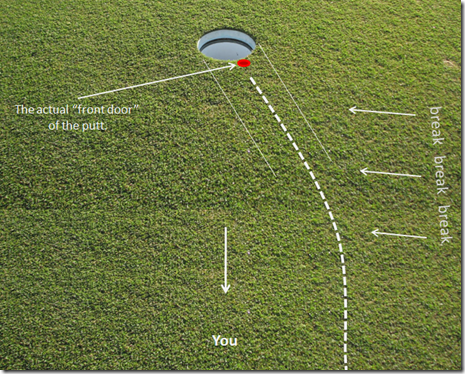
Dave Stockton says to Pay Attention to the Actual Front Door of the Cup
The cup is only 4.25 inches, we can’t afford to be giving up any part of it.
Breaking the Putt Into Thirds
Further Stockton suggests that when reading the putt, you mentally break the putt into thirds, three equal distances between the ball and the cup.
When reading break in the putting green you should not put equal importance on each of the three parts of the putt.
Stockton says you should put very little thought into the first third, slightly more into the second third and the most importance on the last third. The last being the closest to the hole and the reason for the extra importance is the fact that the last third is where the ball will do most of its breaking because this is where it is losing momentum and rolling the slowest.
Mistake #2 is the practice strokes. Being that Dave Stockton believes that the putting stroke should be a mental exercise and not a physical activity, there is no place for the practice strokes.
Practice strokes do nothing but take the subconscious aspect out of the putt.
The Pre-Putt Routine
The mind is a complex piece of machinery and it will perform the best when conditioning is introduced. The pre-shot routine in putting is incredibly important because it takes away the extra thinking, primarily negative thoughts that will do nothing but stand in the way of success.
When you have a SHORT and CONSISTENT pre-shot routine that includes only positive thoughts that revolve around the ball rolling into the cup, you have overcome the most overwhelming aspect of missed putts.
1) Preliminary read of the break standing at the low side of the putt
2) Then walk behind the ball and kneel down as low as possible to read the break from behind the ball
3) Visualize the putt all the way through from the time it leaves the putter head, takes the break and rolls into the cup – paying particularly close attention to which side of the cup the ball will drop into
4) As you are walking towards the ball to address, make a rolling motion with your right hand as though you are rolling the ball with your hand, this is to judge the speed mentally and DO NOT take a practice stroke
5) Address the ball placing right foot first and then adjust to the line with your body, only moving your left foot, Stockton suggests that you place slightly more weight on the front foot.
6) When fully addressed your eyes should be directly over the ball and then you should take ONE MORE LOOK at the hole, again visualizing the putt as it takes the break and rolls into the hole
7) Stroke the putt within 2 or 3 seconds from the time you are comfortable with your alignment
Make Every Putt A 2 Inch Putt
During the setup and alignment phase, Dave Stockton suggests that you pick a spot within two inches from the front of your putt as a target point. The concept is that you are going to hit a 2-inch putt 100% of the time and this essentially turns each putt into a 2-inch putt.
Further, the two-inch putt idea is based on the concept that a putt should be rolled and not struck. Dave Stockton makes an interesting point here, he contends that we all naturally know that we should follow through when we throw a dart, but some people finish their putting stroke at the point of contact and do not follow through enough.
I had a hard time with this as I like to concentrate in at the exact point I feel the putter face should make contact with the ball. I do feel this will help people who have a tendency to get yippee over short putts.
Dave Stockton Says “Keep the face low”
The actual putting stroke itself is very important and the only area where physical activity should be concentrated on.
The normal motion the hands, arms, and shoulders want to take the putting stroke on is, back, putter face open and high, down and putter face closing at contact, ultimately winding up very closed and RISING UP during follow through. This is wrong. The putter face should stay closed in the backswing and open during the follow through, aimed at the target as much as possible.
1) The grip should be hands high, when your hands get too low they are more likely to open and close the putter face.
2) During the back stroke keep the putter head very low to the ground
3) During the follow through, keep the putter face VERY LOW as well
The back stroke should be as LOW and STRAIGHT as possible, as should the follow through.
If you’re having a hard time keeping the putter low and on the target line, you may be setting up too far from the ball.
This is going to be much easier when you are playing on fast greens and when rolling putts from within 25-30 feet. Longer putts will obviously require more lift on the putter head.
The putter head remaining low will stop you from blocking putts to the right or pulling putts to the left. THIS IS VERY EFFECTIVE.
During the follow through, the shaft and putter head should be as vertical (up and down) as possible, the putter head should not be out in front of the grip or the shaft.
Stockton suggests that the weak arm, wrist and hand should wind up in a directly straight and vertical line with the putter grip, shaft and head at the finish.
The whole piece, left arm, grip and shaft should all “clear the body” in other words they should all be visible to someone standing directly behind your back as you are putting.
To further emphasize this point Dave Stockton says that you should actually imagine that you are rolling the putt with the back of your left hand, keeping that weak left hand aimed directly at the target all the way through the putting stroke.
When that left hand is aimed at the target the entire way through the putt it CANNOT RELEASE or turn over to the closed position and Stockton suggests that the release of the left hand is what kills the putting stroke.
KEEP THE RIGHT WRIST LOCKED
DRILL: Dave Stockton developed a drill to help you get the feel of back of the left hand putting stroke.
Make a left hand only putting stroke and take your right hand and place it up on your left shoulder while making the stroke. This drill will help you keep the back of the left hand aimed at the target and having your right hand up on the left shoulder will help you keep the left shoulder low
If the left shoulder is kept low, the putter head will remain low as well.
Suggested Reading: 7 Putting Drills to Help You Avoid 3-Putts and Control Distance
The Forward Press
Dave Stockton is a huge promoter of the forward press, a slight move forward with the hands, once the putter face has addressed the ball. This de-lofts the putter face just a bit, most putters come with 4 degrees of loft.
If you have ever tried using a forward press, you may notice that you tend to hit more solid putts when using it. It just seems as though you are far less likely to blade putts off the bottom of the putter face.
If you are addressing the putt correctly and keeping the back of the left hand aimed at the target, it may not be necessary. Many of Stockton’s students do not use it, this is because they are addressing the ball correctly each time.
Try it out for yourself and see if it works for you. Mickelson is a notorious forward presser and it hasn’t worked out very well for him in recent years.
The Stockton Putting Grip
Weak hand high and strong hand low.
Thumbs on top of the putter.
Left or top fore finger over lapped on top of the right little finger.
Grip pressure should be as though you are holding a bird and you don’t want to hurt it, but you don’t want it to get away either.
Grip pressure should remain consistent all the way through the putt.
Back of the left hand should remain aimed at the target.
Right wrist should remain locked so it doesn’t release.
Wrists as straight as you can make them as to keep the hands as high as possible.
REMEMBER: The higher the hands, the better the finish potion.
Recap of the Stockton Signature Method
- Have confidence in your brain’s ability to perform, let the subconscious mind do its work.
- Read from the low side of the putt and behind the putt from a low angle only.
- Visualize the putt rolling and dropping in the cup.
- Know where the front door of the cup is based on the break of the green.
- Get your eyes directly over the ball.
- A Putt should be rolled and not struck, simply allow the ball to be in the way of your smooth stroke.
- Aim the back of the left wrist at the target at all times.
- Keep the back stroke and the follow through AS LOW AS POSSIBLE.
- NO PRACTICE STROKES
- Don’t take time behind the putt, when you think too much the mind will introduce negative thoughts unnecessarily.
- Have a consistent pre-putt routine that is SHORT and exactly alike each and every time.
- BELIEVE AND KEEP IT SIMPLE – VISUALIZE
- Keep it in the subconscious mind
Putting is not an activity that has anything to do with athletics, you could be young and have a swing like Dustin Johnson but if you’re not believing the putt will go in, you’re done.
The 774-year-oldat your club could be the best putter you know, it’s 90% mental.
My Results – Dave Stockton Signature Putting Concept
In case you care, I have always been a pretty solid striker of the golf ball. I haven’t topped a driver or bladed an iron dead right in a long time. However, putting has always been a huge problem.
I would consistently put myself in position for eagle on par 5’s or for a birdie putt and 3 putt or even sometimes 4 putt.
When I began paying attention to the Stockton Signature concept I began practicing my putting less, instead I would spend my time chipping.
Before each round I have been concentrating on putts of varying lengths and just judging the speed of the greens, only spending about 10 minutes or less putting. The only mechanical things I work on at all is:
a) keeping the putter head low
b) aiming the back of my left wrist at the target
I’m quite pleased to say that once I let the sub-conscious do my putting and I began putting unconsciously I haven’t 4 putted once and I have not 3-putted since August 15th. Six rounds later and no 3-putts.
Thank You Dave Stockton.

